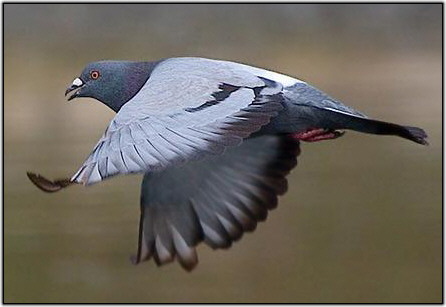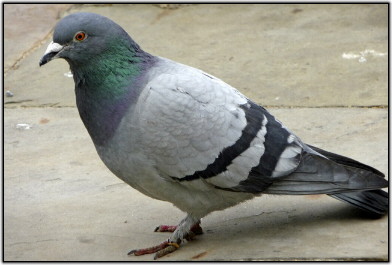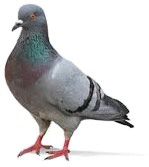Pigeon
 Origins
Origins
Pigeons and doves have been around for a long time—long before humans. Rock doves are thought to have originated in southern Asia several million years ago. Compare this to modern humans that first appeared about 120,000 years ago.
Size and Weight
A pigeon is about 13” (32cm) in length from bill to tail and weighs a little less than a pound (0.35 kg). Males are slightly bigger than females.
A pigeon family:
- Hen: an adult female pigeon
- Cock: an adult male pigeon
- Hatchling: a newly hatched pigeon just a few days old
- Squab: a young pigeon from one to 30 days old. When ready to leave its nest, a squab can sometimes weigh more than its parents.
- Peeper or Squeaker: a young bird that is learning to eat
- Fledgling: a bird that is ready to fly or that has just taken its first flight
- Juvenile: a bird out of its nest and flying but less than eight months old
- Nest and roosting sites: A pigeon nest usually is constructed on covered building ledges that resemble cliffs, a rock dove’s natural habitat. They also nest and roost on the support structures under bridges in cities and along highways.
Nesting
A pigeon nest usually is constructed on covered building ledges that resemble cliffs, a rock dove’s natural habitat. They also nest and roost on the support structures under bridges in cities and along highways. Pigeons build their nests with small twigs. A cock brings the nesting material to his mate, one piece at a time, and she builds the nest. Nests are usually well-hidden and hard to find.
Breeding
Pigeons usually lay two white eggs. The parents take turns keeping their eggs warm (incubating). Males usually stay on the nest during the day; females, at night. Eggs take about 18 days to hatch. Both male and female parent pigeons produce a special substance called “pigeon milk”, which they feed to their hatchlings during their first week of life. Pigeon milk is made in a special part of the bird’s digestive system called the “crop”. When hatchlings are about one week old, the parents start regurgitating seeds with crop milk; eventually seeds replace the pigeon milk.
Colouring and Feathers
There may be as many as 28 pigeon colour types, called “morphs”. Pigeons also have colourful neck feathers. These iridescent green, yellow, and purple feathers are called “hackle”. Adult males and females look alike, but a male’s hackle is more iridescent than a female’s. White feathers are actually feathers that have no colour pigments. So, when you see white on pigeons you are actually seeing no colour.
Adults have orange or reddish orange eyes; juveniles that are less than six to eight months old have medium brown or grayish brown eyes. Pigeon legs and feet are red to pink to grayish black. Their claws are usually grayish black but can be white on some pigeons. Some birds have “stockings”, which are feathers on their legs and feet! The cere is the fleshy covering on the upper part of a pigeon’s beak. It is grayish in young birds or juveniles, and white in adults. Albino birds may have pinkish ceres.
Pigeons have many types of feathers, including contour feathers, the stiff feathers that give the body its shape, and down, the fluffy insulating feathers. Many pigeon feathers are accompanied by one or two filoplume feathers, which look like hairs. These filoplumes may have sensory functions, such as detecting touch and pressure changes.

Senses and Calls
Pigeon eyesight is excellent. Like humans, pigeons can see colour, but they also can see ultraviolet light—part of the light spectrum that humans can’t see. Pigeons are sometimes used in human search-and-rescue missions because of their exceptional vision.
Pigeons can hear sounds at much lower frequencies than humans can, such as wind blowing across buildings and mountains, distant thunderstorms, and even far-away volcanoes. Sensitive hearing may explain why pigeons sometimes fly away for no apparent reason: maybe they heard something you can’t.
Pigeons make two types of sounds: vocal (using voice) and non-vocal. The primary call used by males to attract mates and defend territories is coo roo-c’too-coo. From their nests they might say oh-oo-oor. When they are startled or scared they might make an alarm call like: oorhh! Pigeon babies make non-vocal sounds such as bill snapping and hissing. After mating, males often make clapping sounds with their wings.
Behaviour
Most birds take a sip of water and throw back their heads to let the water trickle down their throats. But pigeons (and all of their relatives in the family Columbidae) suck up water, using their beaks like straws.
Do pigeons have compasses in their heads? Not really, but pigeons, especially those bred for their homing instincts, seem to be able to detect the Earth’s magnetic fields. Cornell University pigeon researcher Dr. Charles Walcott says that magnetic sensitivity, along with an ability to tell direction by the sun, seems to help pigeons find their ways home.
On the ground, pigeons don’t hop the way many birds do. They walk or run with their heads bobbing back and forth. Pigeons are strong fliers and can fly up to 40 or 50 miles per hour. Some pigeons are raised for their exceptional abilities to fly fast and find their ways home. These pigeons may fly as far as 600 miles in a day. Although feral pigeons are good fliers too, most of these birds seem to stay close to their regular feeding sites.

Natural Predators
One species of falcon, Merlin, eats so many pigeons its scientific name is Falco columbarius (with the “columba-” meaning pigeon) and it was formerly called pigeon hawk. Merlins are medium-sized falcons and although they are not very common in cities, you can bet they are preying on pigeons living in open parks near marshes and ponds. In cities where peregrine falcons have become established, they catch and eat feral pigeons, often carrying them back to feed to their nestlings. Red-tailed and Cooper’s hawks also prey on pigeons in cities and in rural areas.
Fancy Pigeons
People raise all kinds of fancy pigeons. The breeds have names, such as rollers, tumblers, and fantails, which reflect the way the birds fly or the way they look. Sometimes, people take their fancy pigeons to compete in shows.

